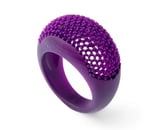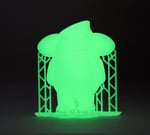What can you 3D print with? Practically anything. Seriously, the list ranges from chocolate to titanium.
What’s the best material for your project? Well, that’s harder to say, but the more you know about the options out there and the attributes of various materials, the better your parts will turn out. In fact, materials, in the long run, will make up the bulk of your 3D printing investment, so it will pay to do a little research in advance.
Here at All3DP, we have hundreds of guides to 3D printing materials, from the best carbon-fiber-infused filaments to the best nylon powders. We print every day and test and compare various materials. Whether you’re a home hobbyist just getting started or a seasoned engineer looking to build a better industrial component, we’ve got you covered.
In this ultimate guide, we will take a look at every 3D printing material category as well as special attributes, such as flame-resistant and bio-compatible.
Whether you’re looking for the right filament or the best-suited resin, this concise guide will help you select the best material for your next project to improve the quality of your prints.
Understand Material Formats: Filament, Resin, Powder, Pellets, Wire, Paste, Gel
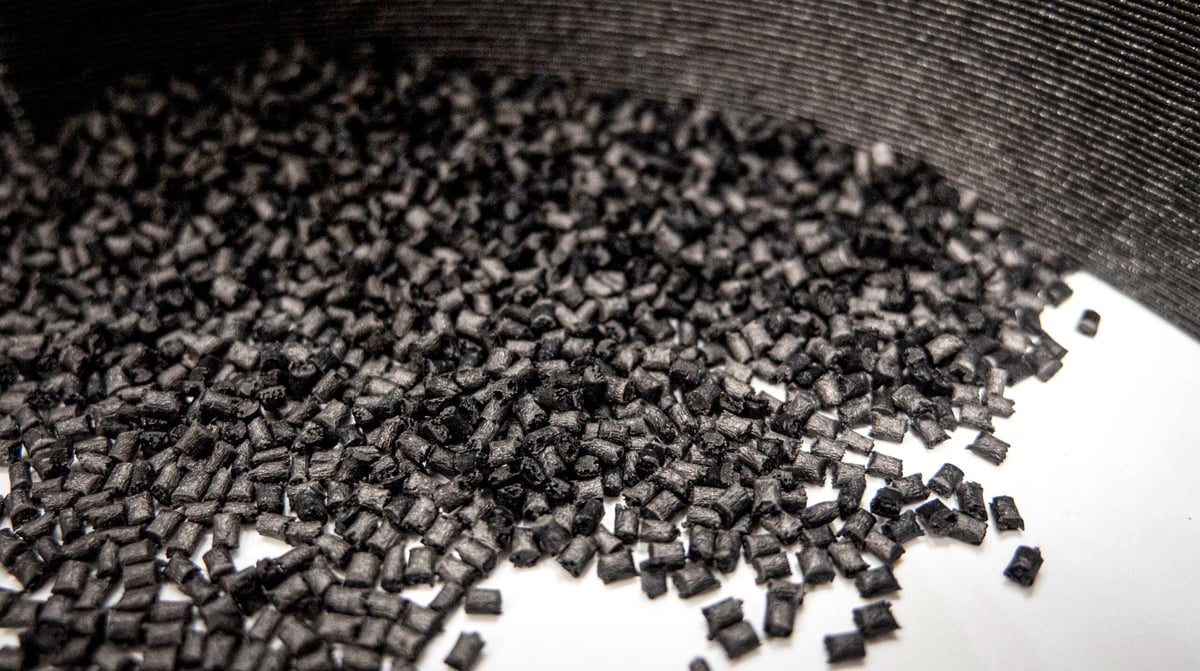
If you already have a 3D printer, you know what type of material to feed it. Fused deposition modeling (FDM) uses spools of filament, liquid crystal display (LCD) uses bottles of resin, selective laser sintering (SLS) uses powder, and so forth.
If you’re starting with the desired material and working backward to match your 3D printer to it, you should know that there is often more than one technology to choose from per material. For example, carbon fiber nylon is available as a filament, pellets, and powder, so it’s applicable to both FDM and SLS, while aluminum comes in filament, powder, and wire for various 3D printing technologies, each having unique attributes and costs.
Most 3D printing materials are unique to 3D printing but more often today, standard manufacturing materials, such as the polymer pellets used in injection molding or metal wire used in welding can be fed to 3D printers and are often the more economical solution.
Filament
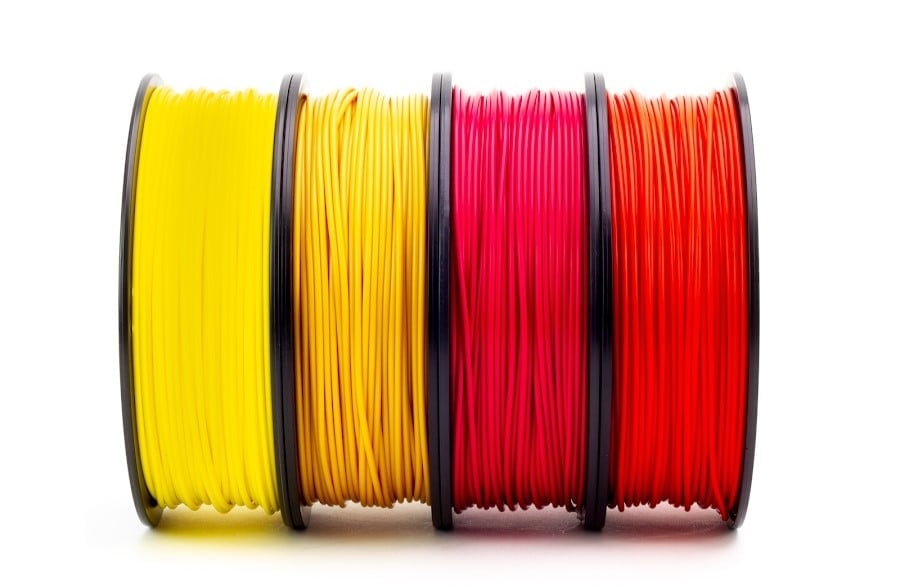
The most popular way to 3D print is with a fused deposition modeling (FDM) printer, which has traditionally been the easiest and cheapest way to 3D print. This type of 3D printer uses material in filament form, which is a spool of a plastic cord.
FDM printers heat the plastic to near melting and extrude it in layers. The most common filaments are made of the thermoplastics PLA, ABS, and PETG, but there are so many, many more out there that expand what you can create with your FDM printer.
From functional models like tools or prosthetics to fun objects like games or figurines, there’s a filament out there that’s best suited to the task at hand.
PLA: All-Rounder
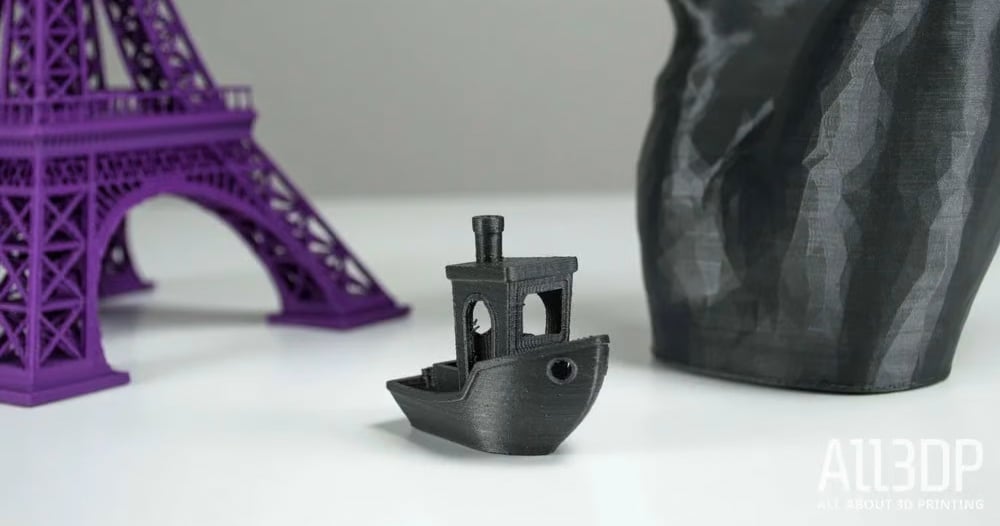
A crowd favorite in our 3D printing materials guide is PLA. It’s affordable, easy to print with, and practically universally compatible with FDM printers. PLA is short for polylactic acid, a thermoplastic polymer derived from renewable resources, specifically corn starch or sugar cane. It can be recycled at industrial facilities but is not biodegradable.
It has a low printing temperature, doesn’t need a heated bed (although it helps), and doesn’t warp as easily as other materials so it’s easy to print with. Another benefit of using PLA is that it doesn’t give off much of an off-putting odor during printing (unlike ABS). It is a suitable 3D printing material for single-use food contact. However, PLA is less durable than ABS or PETG and susceptible to heat. Avoid using it when making items that might be bent, twisted, or repeatedly dropped, such as phone cases, high-wear toys, or tool handles.
PLA is available in a broad range of colors and composites or additives, like these:
ABS: Rock-Hard
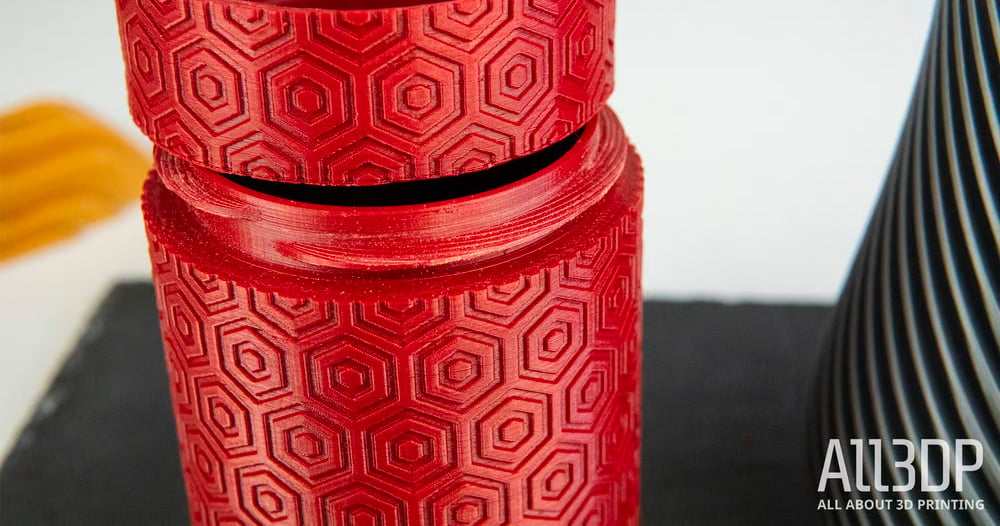
Remember the quality of Lego bricks? Then you can relate to why ABS (acrylonitrile butadiene styrene) is one of the most popular 3D printing materials to date. Made from petroleum, ABS is commonly used in injection molding and is found in many household items, such as those rock-hard Lego bricks, phone cases, or bicycle helmets – due to its durability, robustness, and temperature resistance.
While it plays a major role in commercial applications such as rapid prototyping, in hobbyist 3D printing, ABS is less popular. This is due to it being slightly more difficult to print – it’s prone to warping without an enclosed and heated build chamber.
ABS is used high-wear toys, tool handles, automotive trim components, and electrical enclosures. It is readily affordable, strong, lightweight, allows for easy post-processing, and comes in a broad range of colors. However, ABS releases smelly and toxic chemicals known as VOCs during printing. Address this by printing in a well-ventilated area and/or with an enclosure. Not being in the room while printing is also recommended.
ABS Printing Tips:
PETG: Food-Safe
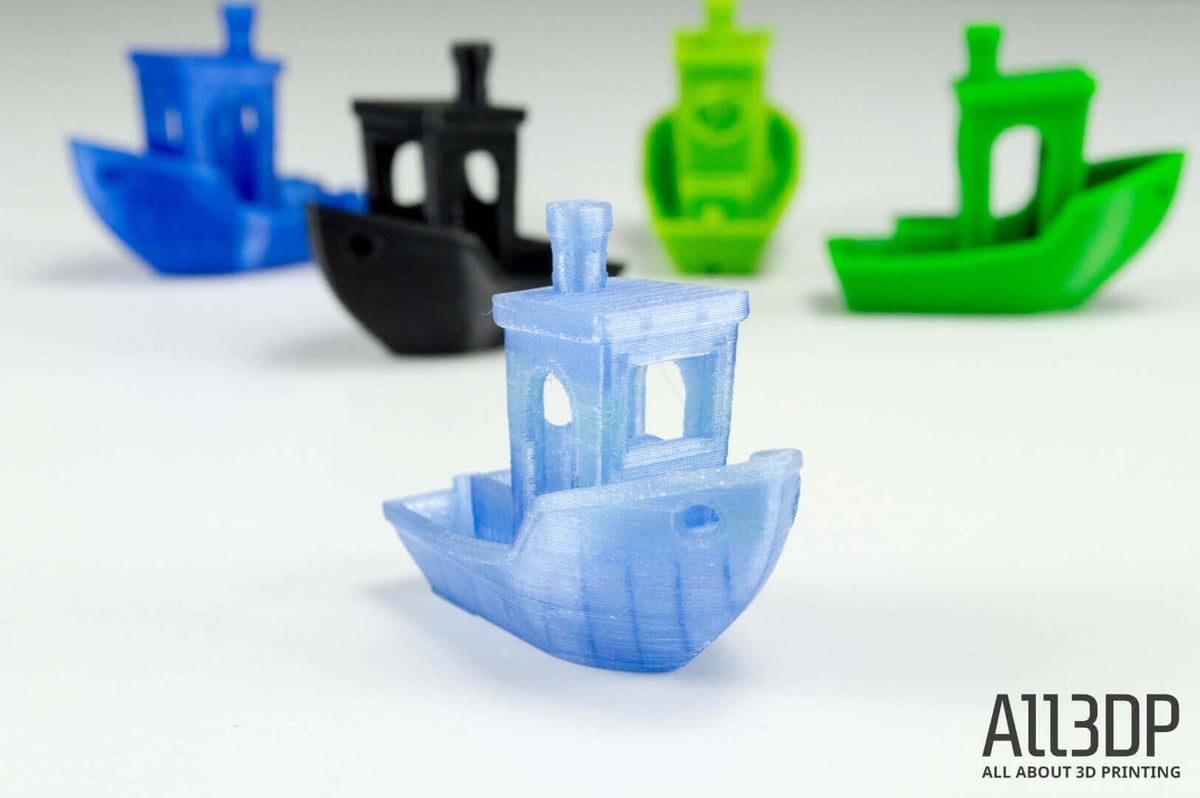
PETG is made from polyethylene terephthalate (PET), the material you know from plastic water bottles, but some ethylene glycol is replaced with CHDM (cyclohexanedimethanol) — hence the letter “G” after PET for “glycol-modified”. The result is a filament that is clearer, less brittle, and easier to use than its base form of PET.
It’s an excellent filament choice for printing objects that need to be sturdy, have a smooth surface, and have lower shrinkage. PETG components are weather-resistant and are thus often used for garden appliances. It’s also popular because PETG is considered food-safe — but you should still read the fine print on any spool you buy to be sure.
Of course, it’s not all good news: PETG isn’t great at bridging because it’s super sticky, but this does mean it has great layer adhesion. It’s also more hygroscopic than PLA, so it can be prone to both heavy stringing and air-moisture absorption if left out. But still, if you need a good all-around, high-strength material that is less complicated to print than ABS, PETG is a great option.
There are more variations of PET in filament than just the familiar glycol-added version. You’ll find recycled PETG and some carbon-fiber-infused PETG to give it extra strength.
PETG Printing Tips:
TPU, TPE, TPC: Flexible
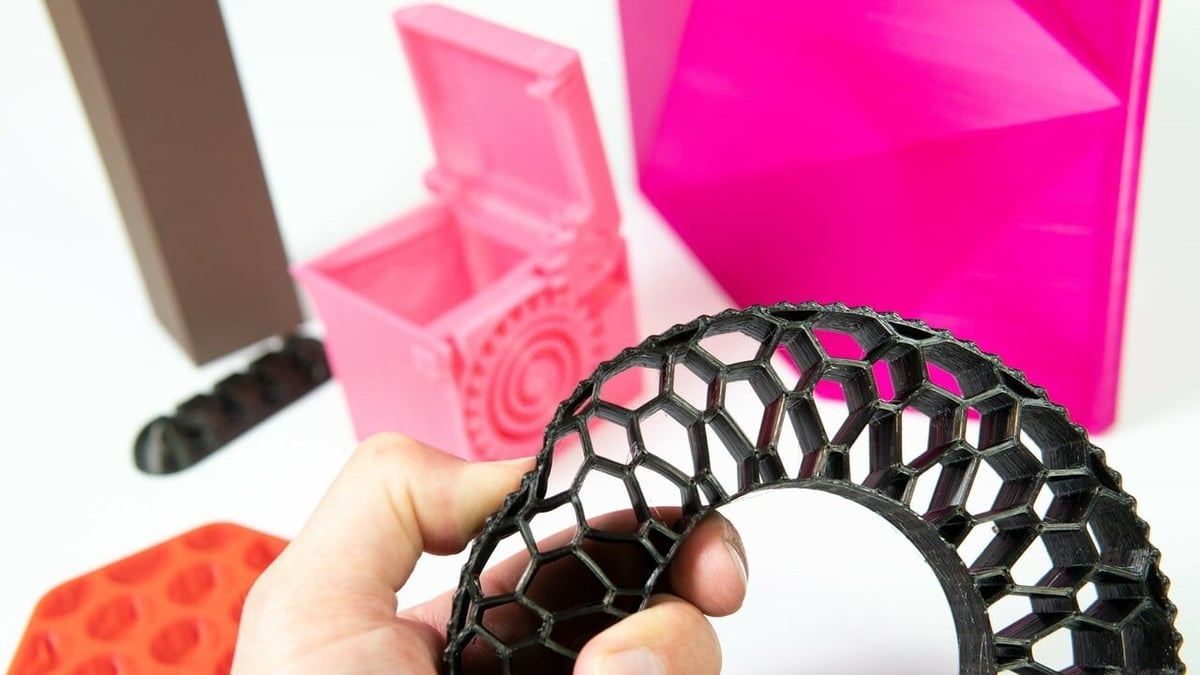
TPEs (thermoplastic elastomers) are a class of materials that are a blend of plastic and rubber, and include TPU (thermoplastic polyurethane), TPC (thermoplastic co-polyester), and others.
These plastics are very soft and flexible. They are becoming more common in additive manufacturing to produce parts that can be bent or stretched without any deformation. TPUs are also generally more durable and can offer higher resistance to abrasion, oils, chemicals, and high and low temperatures than TPE filament. TPC boasts high-temperature resistance and excellent UV resistance. It is especially prized in biomedical applications and for wearable and medical devices. TPEs are also available in powder and resin.
It is not that easy to print, however and requires good control of the printing process. Dried filament, as well as proper bed heating, nozzle temperatures, and print speeds, will guarantee success with this versatile material.
TPU Printing Tips:
Nylon: Tough & Durable

Polyamide (PA), commonly known as nylon, is a tough and durable material used for a wide range of applications. The material stands out for its toughness and its resistance to high temperatures and impacts. It offers good tensile and mechanical strength.
PA is commonly reinforced with carbon, glass, and kevlar fibers, or embedded with continuous carbon fiber, for added reinforcement. Widely used in high-end engineering applications, such as gears, jigs, fixtures, and tooling, PA is also available as a powder.
Although you shouldn’t expect it to print as easily as PLA or PETG, printability shouldn’t be a deal-breaker, but you may need a high-temperature nozzle, as some blends will need up to 300°C to be processed. Proper storage for nylon is also critical since it can soak up water when left out in the open. This moisture degrades the material and yields poor print quality and strength.
ASA: Sunlight Resistant
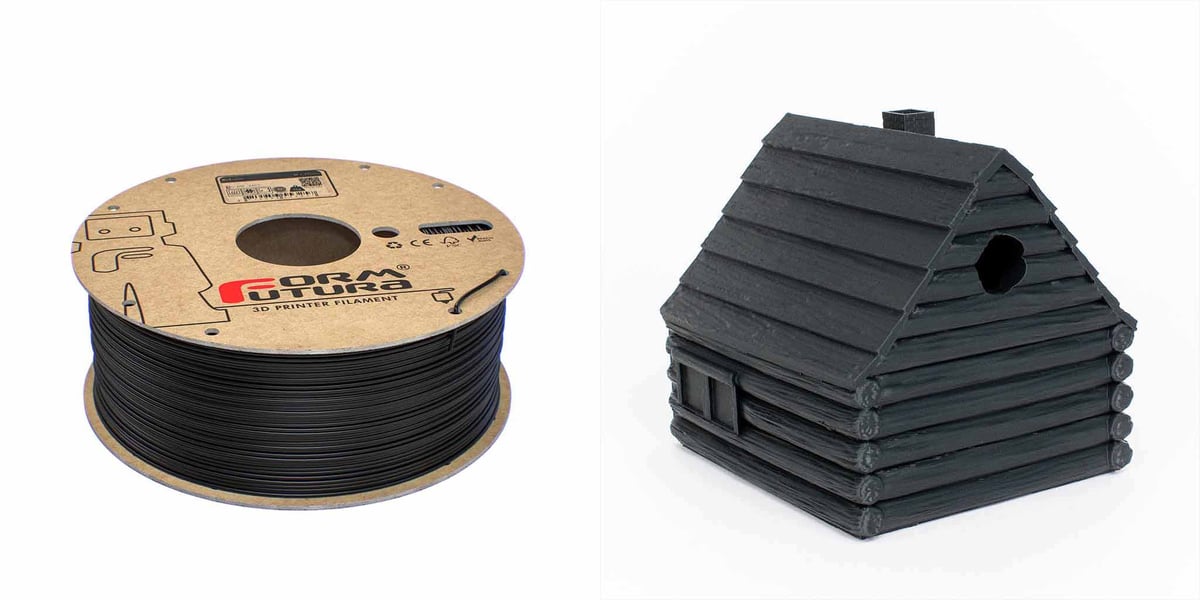
This tongue twister of a material called acrylonitrile styrene acrylate is known for high impact strength and chemical resistance. It is also UV-stable, keeping its material properties and appearance even when exposed to sunlight and making it an ideal material for outdoor use.
It’s the easier-to-print cousin of ABS, but also requires high extruder and bed temperatures as well as an enclosure to counteract warping, cracking, and shrinking. It is certainly not for every printer, but it can be handled by more capable desktop machines and, naturally, industrial FDMs.
ASA Printing Tips:
PVB: Smooth & Clear

PVB, short for polyvinyl butyral, is a specialty filament that is most known for its ability to be layer smoothed with Isopropyl Alcohol. This makes it a safer alternative to ABS, which needs acetone for layer smoothing. Polymaker for example offers a variety of PVB filament colors to be processed in their Polysher, an alcohol mister, for even results. Plus, PVB is a transparent material, so translucent and clear prints are also achievable.
PVB has similar material properties to PLA, only with the exception that it has poor layer adhesion and therefore inferior mechanical properties, which is definitely a drawback. It also has relatively higher hygroscopic properties, so make sure to keep your filament dry. If you want to print smooth models for the purpose of placing them on a shelf to impress visitors, it could be worth looking into PVB.
HIPS: High-Impact
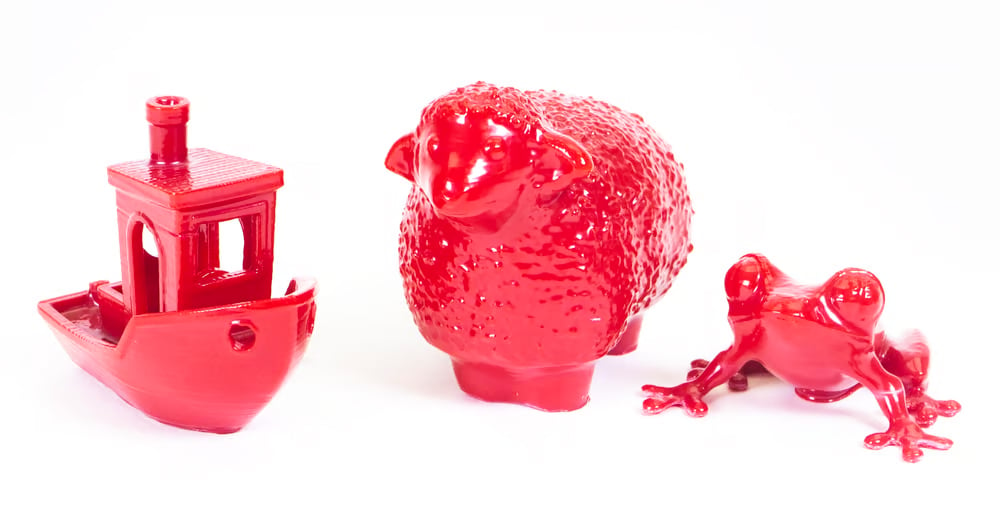
High impact polystyrene (HIPS) is a material blend of polystyrene plastic and polybutadiene rubber. The mixture of these polymers results in a material that’s both tough and flexible.
HIPS is very similar to ABS, but as the name implies, it can withstand much higher impact forces. It’s easily painted, machinable, and works with a large number of adhesives. Moreover, it’s food-safe, being declared FDA-compliant for food processing applications.
Within the 3D printing world, HIPS is mostly used as support material since it dissolves in limonene solution, eliminating the need for removal via abrasives, cutting tools, or any other such things that leave your print less than perfect. This characteristic can also be used to smooth HIPS and obtain shiny surfaces, something that’s very hard to achieve with PLA. Limonene is a solution made with lemon peels and it can be easily obtained. This solution, however, can potentially damage 3D printing materials other than ABS.
PVA: Water Soluble
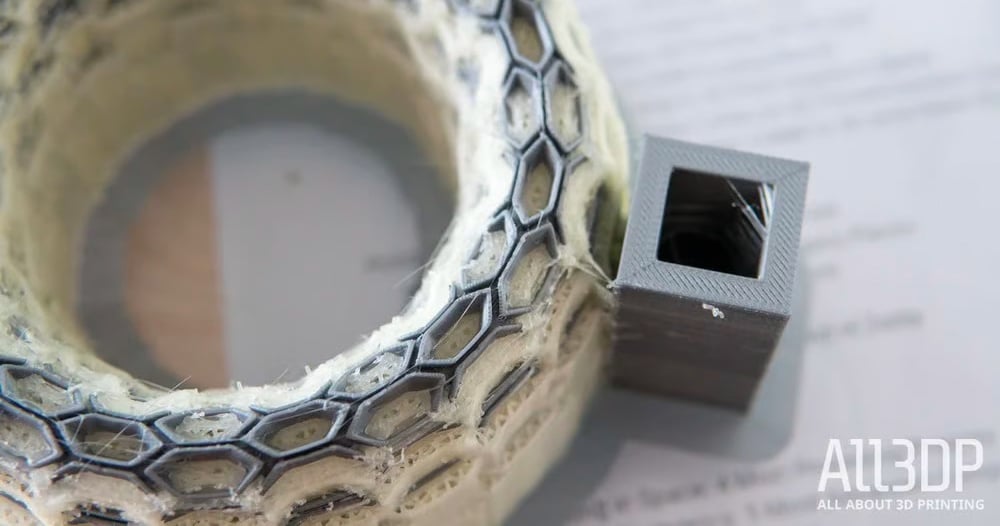
Polyvinyl alcohol (PVA) is soluble in water, and that’s exactly what commercial applications take advantage of. For 3D printing, PVA, like HIPS, is engineered for use as a soluble support material, primarily when paired with another 3D printer filament in a dual extrusion 3D printer. The advantage of using PVA over HIPS is that it can support more materials than just ABS.
The trade-off is a 3D printer filament that is slightly more difficult to handle. One must also be careful when storing it, as the moisture in the atmosphere can damage the filament before printing. Dry boxes and silica pouches are a must if you plan to keep a spool of PVA usable in the long run.
Conductive & EDS Safe
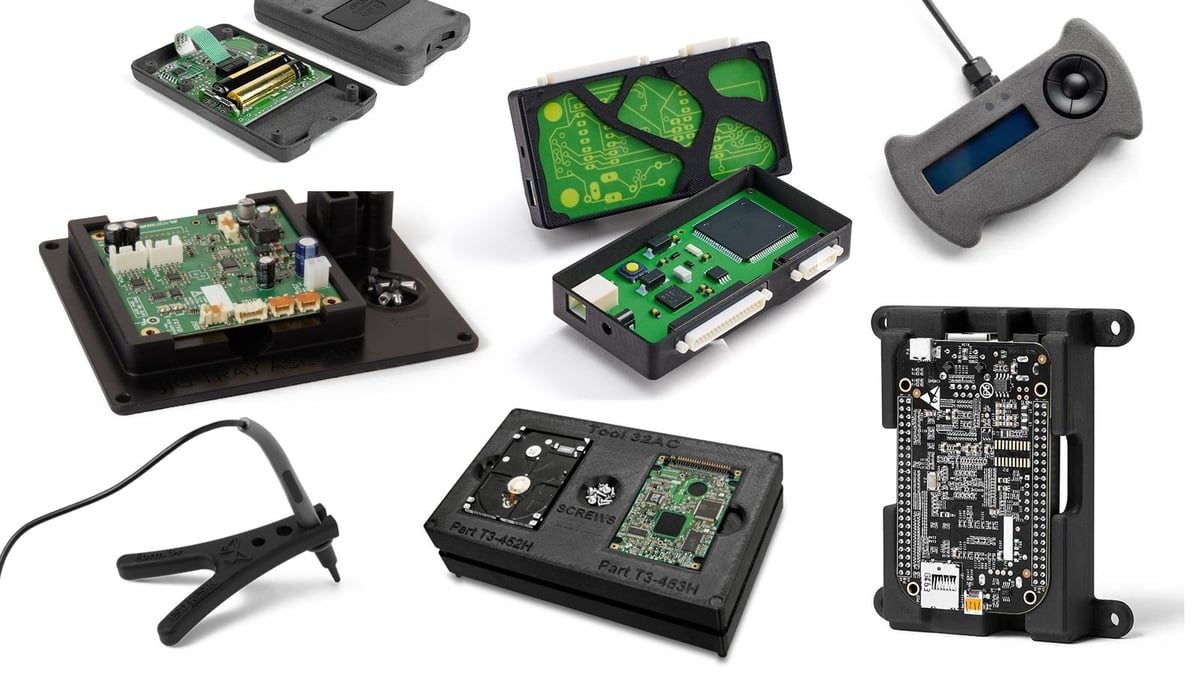
Conductive 3D printer filament does as its name implies: conduct electricity. With the addition of conductive carbon particulates, mostly graphene, to base materials such as PLA or ABS, it’s easy to actualize hobbyist projects by printing low-voltage electronic circuits. Just couple a conductive 3D printer filament with an ordinary PLA or ABS in a dual-extrusion machine.
This handy material can be used to create touch sensors in applications that require human interface devices like gaming pads and MIDI machines. Other maker projects include conductive traces in wearable electronic devices and creating interfaces between computers, Arduino boards, and other components to build elaborate DIY projects. It’s no substitute for a regular PCB, though.
If you want to protect your electronics from electric discharge, then you’ll need an EDS-safe material. 3D printing with electrostatic discharge-safe filament, resin, or powder for your housings, fixtures, and tools can protect them. With these materials, you can print circuit board housings, tools and fixtures used in electronics testing, and more parts and products that will protect your electronics from electrical charges.
Wood Composite
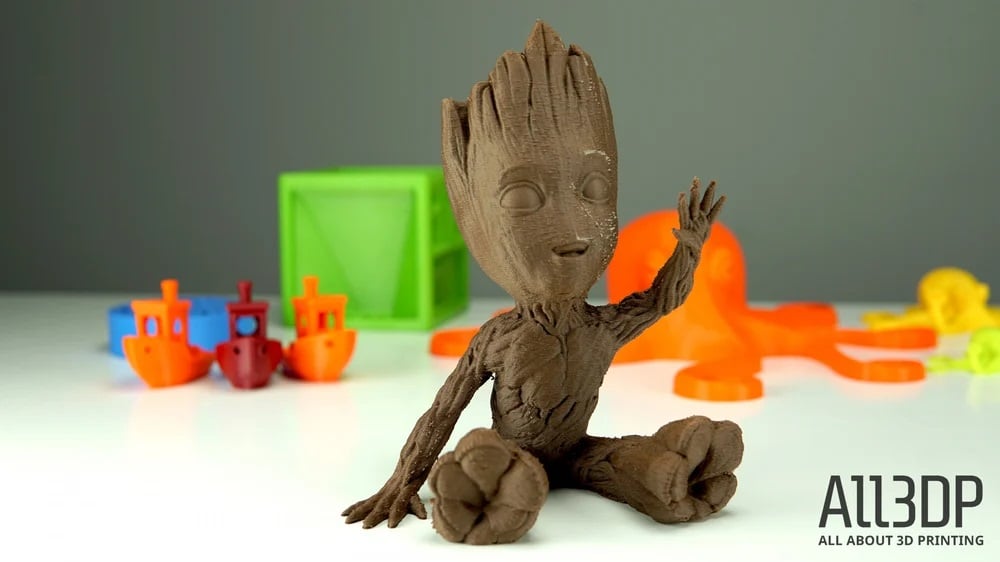
Wood 3D filament is another composite, typically PLA infused with wood fiber. There are many wood-PLA 3D printer filaments available today. These include the more standard wood varieties, such as pine, birch, cedar, ebony, and willow, but the range also extends to less common types, like bamboo, cherry, coconut, cork, and olive.
As with other types of 3D printer filament, there is a trade-off with using wood. In this case, the aesthetic and tactile appeal come at the cost of reduced flexibility and strength. Wood-filled filament can also accelerate the degradation of your 3D printer’s nozzle, so keep that in mind before using this material.
Be careful with the temperature at which you print wood, as too much heat can result in an almost burnt or caramelized appearance. On the other hand, the base appearance of your wooden creations can be greatly improved with a little post-print processing! You can cut it, sand it, or paint it.
Metallic Appearance
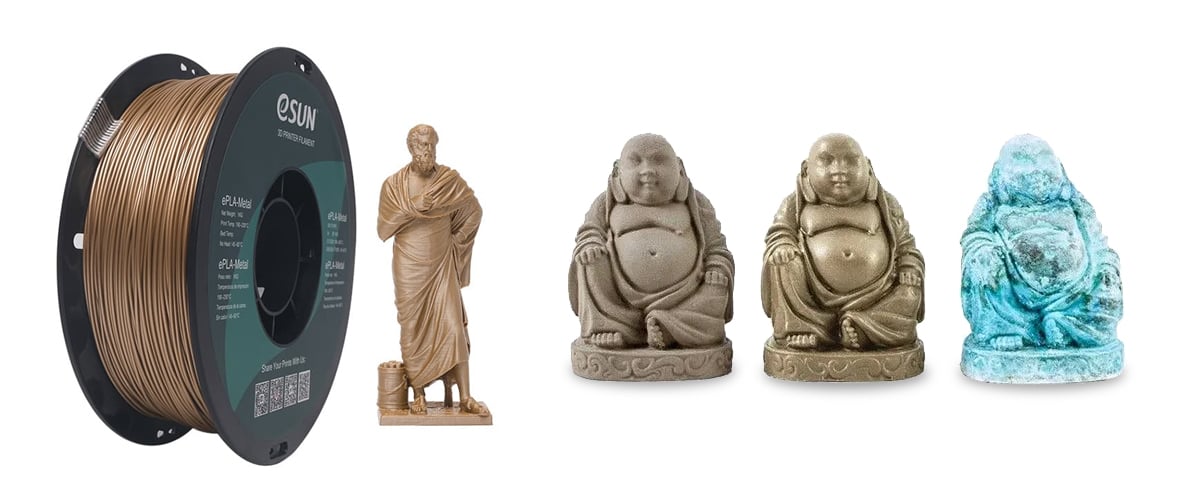
For a metal appearance, filament, usually PLA, is infused with just enough metal to look like metal when the final part is polished. Even the weight is metal-like because these blends tend to be several times denser than pure plastic filament, making this material great for 3D printing trophies. Keep in mind that it won’t have the actual functionality of metal.
If you’re just looking for the shine of metal, silk-like PLA filaments in gold, bronze, and silver color, are also a good option.
Filament with real metal, often called composite material, produces prints can easily pass for metal (visually), and are especially popular for figurines, models, chess pieces, toys, and tokens. It’s great for post-processing, including sanding, polishing, weathering, or tarnishing. When printing with metal composites, expect increased nozzle wear. Therefore, it is recommended to switch your brass nozzle to stainless steel or another hardened alloy, as brass nozzles wear out much faster from metal particle abrasion.
Real Metal
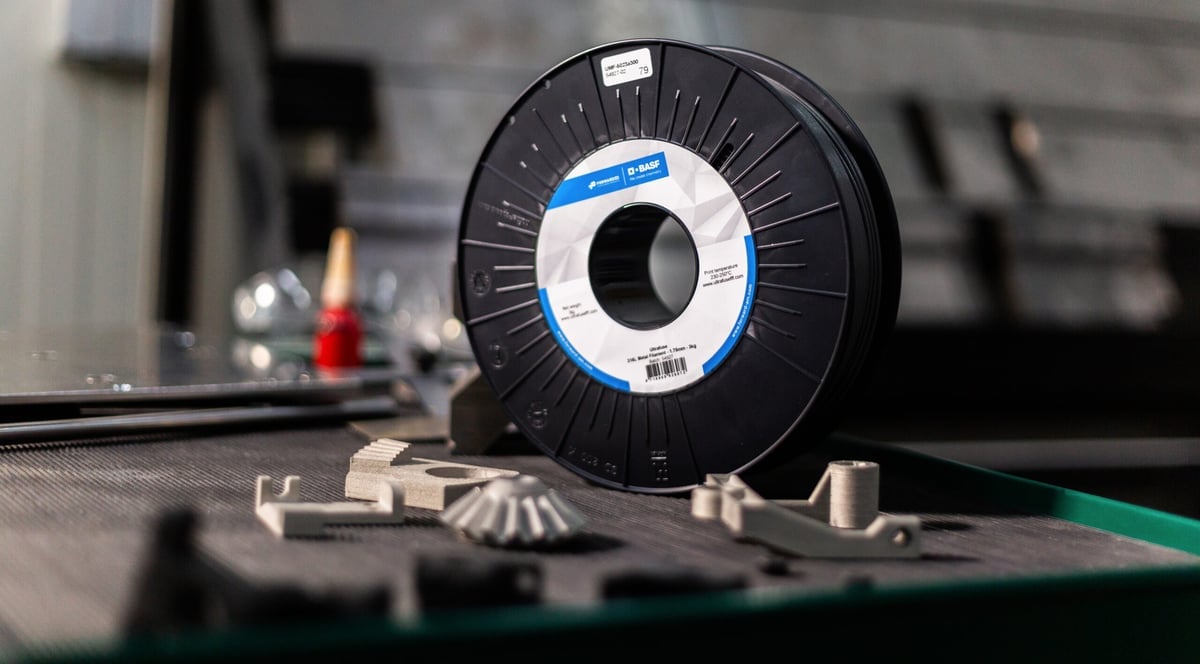
Introduced a few years ago and not skyrocketing in popularity, metal filament is used to create real, solid metal parts. Consumers and professionals are turning to this material to produce everything from figurines to small replacement parts and tools. The benefit is tremendous cost and time savings over machining or molding metal.
Several FDM 3D printer makers, including UltiMaker, BCN3D, Anycubic, and MakerBot, have launched printer profiles that enable you to print with metal filament on their machines. Metal filaments for metal parts are only available from a small handful of producers, including BASF and The Virtual Foundry, and must contain a high percentage of metal powder (around 80%). Note that these parts are not metal right off the print bed, they and go through two post-processing stages to remove the plastic component and then condense the metal part. For a deep dive into printing real metal parts with metal filament, see the guide linked below.
A key benefit of metal filament is how easy it is to print with on a regular 3D printer. Just note that, by “regular”, we mean any FDM printer with a heated bed and a hardened steel nozzle that can reach the required temperatures of at least 180ºC to 220ºC. In theory, this means that you don’t need an expensive machine; you can print it on machines under $200, like an Ender 3 or Anet A8.
PC: Heat Resistant

Polycarbonate (PC) is a strong material that stands out for three main features: optical clarity, resistance to heat, and incredible toughness. When 3D printed, it’s used across industries for automotive headlight prototypes, lamp shades, and translucent cases for electrical components.
- Highly transparent and glass-like
- High toughness down to -20 °C
- High mechanical retention up to 140 °C
- Intrinsically flame retardant
- Good electrical insulation properties not influenced by water or temperature
- Possesses good abrasion resistance
- Withstand repeated steam sterilizations
Price: Filament (1kg) from $60
PEI: High Strength-to-Weight Ratio
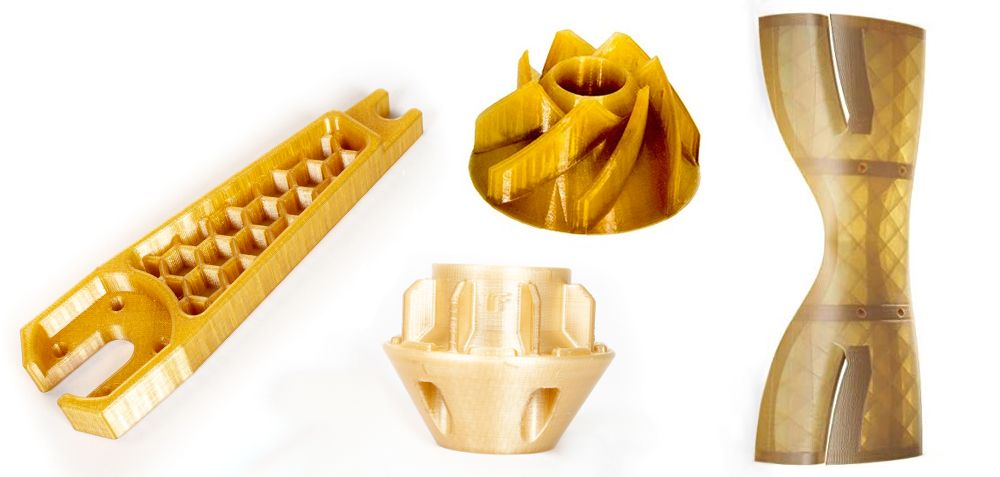
Polyetherimide (PEI) was first developed in 1982 by General Electric Company (now known as SABIC) under the trade name Ultem, as it is still commonly known. This high-performance plastic is characterized by outstanding thermal, mechanical and electrical properties. PEI offers manufacturers a high strength-to-weight ratio making it a cost-effective alternative to metal that’s strong enough to replace steel in some applications and light enough to be used in others to replace aluminum, particularly in aerospace. Other PEI applications include, gear components, valve housings, sensor and thermostat housings, demanding electrical applications, printed circuit boards, and plenum devices. There are many grades of Ultem with the most common being Ultem 1000. Ultem 1010 is a resin material, and Ultem 2300 is a 30% glass-reinforced.
- Very good retention of mechanical properties at extremely high temperatures
- Exceptional specific strength, rigidity, flexibility, and dimensional strength
- Good electrical properties
- Good UV-light resistance and weatherability
- Inherently flame resistant
- Resistant to alcohols, acids, and hydrocarbon solvent but dissolves in partially halogenated solvents
- PEI also displays good hydrolytic stability
- Performs especially well in hot air and water environments
- Most PEI grades are food-contact compliant
Price: Filament (1kg) from $350
PEEK: Lightweight Metal Replacement
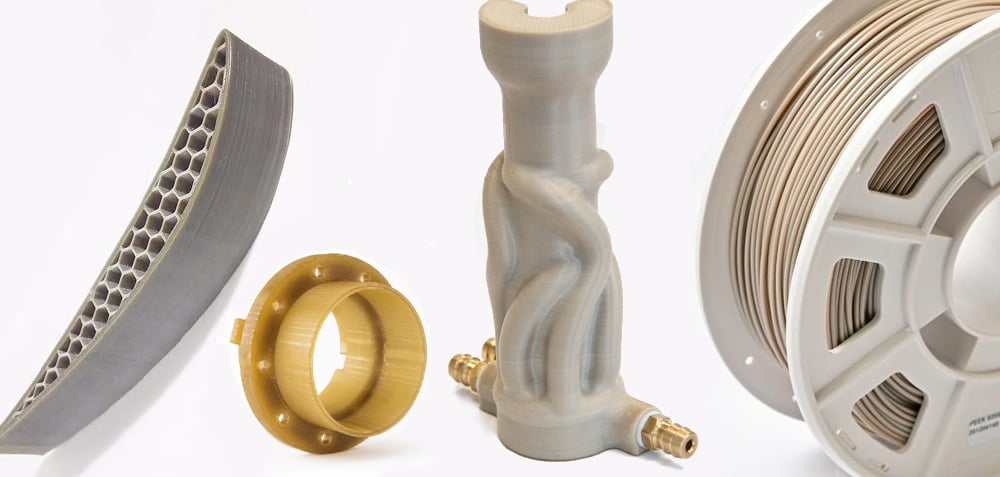
PEEK belongs to the Polyaryletherketone (PAEK) family of polymers and is enjoying growing popularity for applications in the military, pharma, petrochemicals, and food packing.
Its high cost, however, and tricky processing limit it to industrial use with specific printers. PEEK has less than half the weight of aluminum and one-sixth that of steel, making it an excellent metal replacement for parts in the oil and gas industry and in aerospace. PEEK’s properties can be further enhanced by combining it with composite materials, such as glass fiber, graphite, or carbon reinforcements, which help fight shrinkage. PEEK is also used for medical implants (since it is fully biocompatibility and Xray transparent), but there’s a huge difference between industrial and implantable PEEK, with Evonik offering the only fully medically approved PEEK filament on the market to date (priced around $5,000/kg).
- Highly resistant to extreme temperatures up to 260°C
- Resistant to corrosive fluids, gases, and high pressures
- Highly resistant to high-pressure water or steam
- High self-lubrication ability and low friction
- Outstanding creep resistance
- Good dimensional stability
- Low flammability and little smoke emission when combusting
- Exceptional insulation properties
- Excellent sterilization resistance at high temperature
- Fully bio-compatible
Price: Filament (1kg) from $850
PEKK: Stiff & Strong
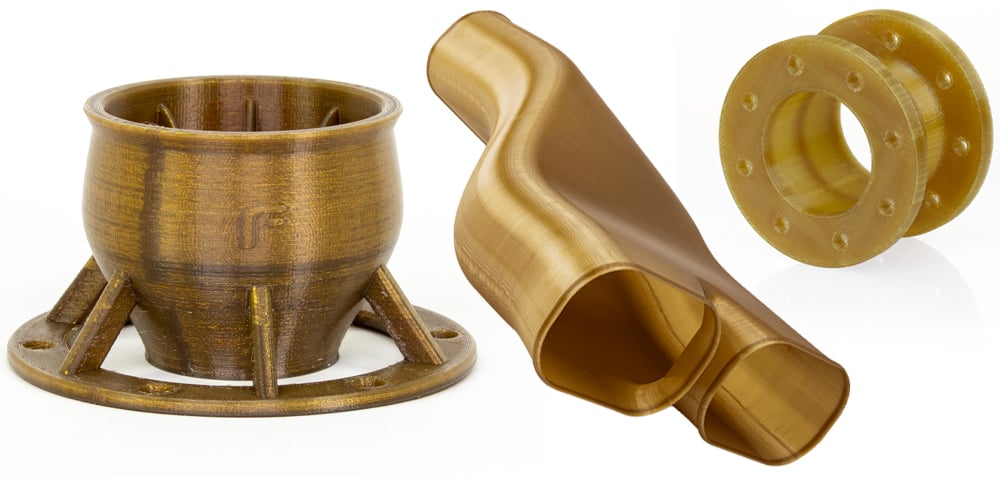
PEKK is another polymer in the Polyaryletherketone (PEAK) family and is one of the highest-performance polymers in world. PEKK has exceptionally good mechanical, thermal, and chemical resistance properties, but boasts far easier printability than PEEK. In fact, PEKK can be processed at lower 3D printing temperatures than PEEK-based filaments, doesn’t require a super-heated chamber (like PEEK), and has excellent layer bonding resulting in parts with exceptional dimensional accuracy and z-strength. This is another versatile high-performance 3D printing polymer that can replace metal and composite parts in various industries from aerospace and automotive to medtech and marine. The material is resistant to hydrocarbons and fluids.
Parts printed with PEKK may be heat treated (annealed) after printing to maximize the mechanical, thermal, and chemical resistance properties. Printed parts will be transparent golden in color and then turn an opaque tan color once annealed.
- High temperature resistance of 255+ ºC
- Very high stiffness, tensile & compressive strength, impact resistance
- Easy to print
- Flame retardant, low out-gasing
- Very limited warping
- Resistant to virtually all organic and inorganic chemicals
Price: Filament (1kg) from $750
PVDF: Resists Extreme Conditions
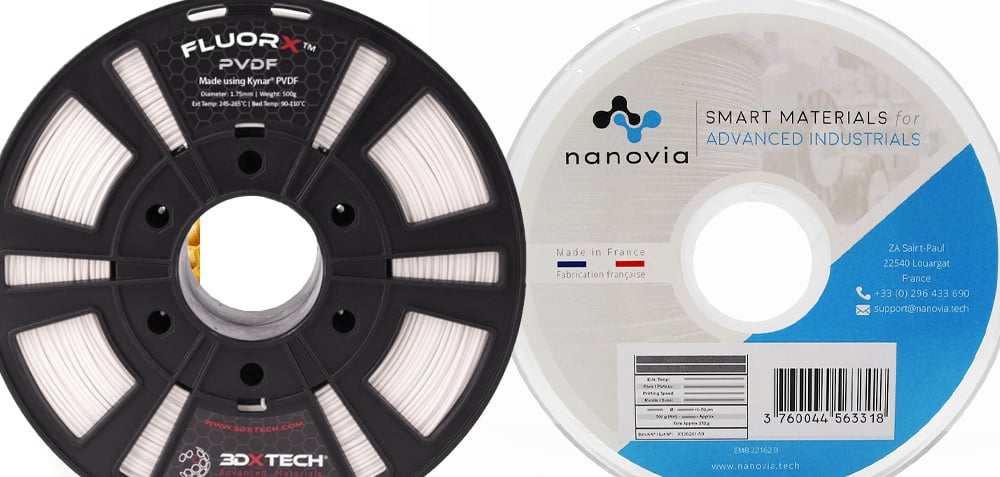
PVDF (Polyvinylidenefluoride) is another polymer gaining applications in additive manufacturing for its unique set of properties. PVDF is widely used in high-tech applications, such as chemical process equipment, semiconductors, lithium-ion batteries, and other electrical, electronic, and energy-related applications. In 3D printing PVDF exhibits very low warp and stands up to the most extreme conditions, even nuclear radiation. Panels made of PVDF are used on space probes and satellites.
- High thermal properties up to 150 °C
- Very low warping
- Excellent resistance to most chemicals, including fully halogenated hydrocarbons, alcohols, acids, and bases
- Non-hygroscopic, does not absorb moisture.
- Long-term hydrolytic stability
- Resistant to nuclear radiation
- Very good abrasion resistance
Price: Filament (1kg) from $250
PPSU: Transparent at Super High Heat
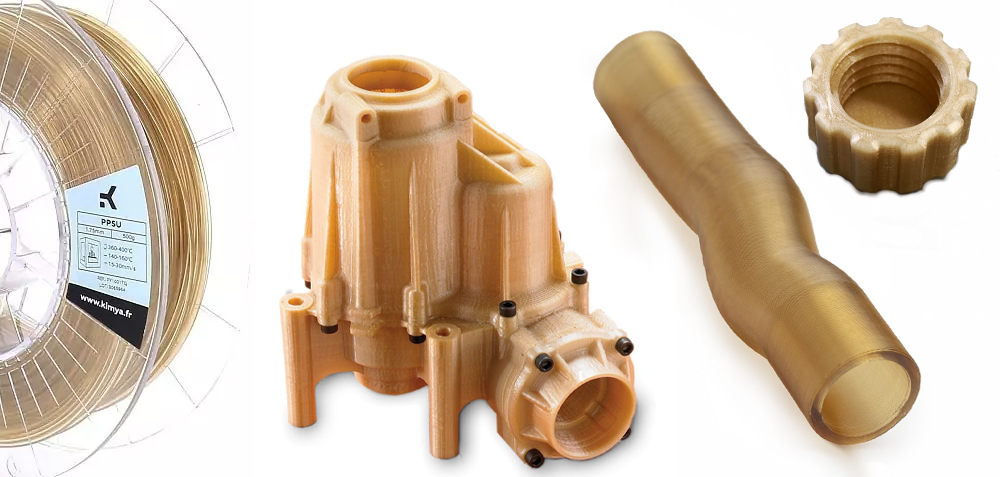
Sulfone polymers (PPSU, PESU, PSU) are another family of high-performance plastics that combine excellent thermal stability, high strength and toughness, excellent hydrolytic stability, transparency, and good resistance to environmental stress cracking. Setting these apart from the PEAK family is their high heat deflection temperatures (similar to PEI) and they are the only thermoplastics that remain transparent at super high temperatures (204 ºC), even after long-term exposure. PPSUs deliver long-lasting performance in hot water and steam, even under pressure, so they are often used to replace brass in pressurized hot water applications. They can be used as a lightweight alternative to metal in surgical sterilization cases and trays, implant trials, surgical instrument handles, and a host of other medical and dental devices. PPSU is also widely used in food service applications and aircraft cabin interiors.
- Outstanding long-term resistance to creep at temperatures up to 150 ºC.
- Easy to process
- Excellent wear resistance under continuous load at high temperatures
- Resistant to acids, alkalis, oils, greases, and aliphatic hydrocarbons and alcohols.
- Good optical clarity
- Very good hydrolytic and sterilization resistance
- Biocompatibility
- Excellent insulation properties
- Outstanding rigidity even at high temperatures
- Low resistance to UV light
Price: Filament (1kg) from $500
Biocompatible Filaments
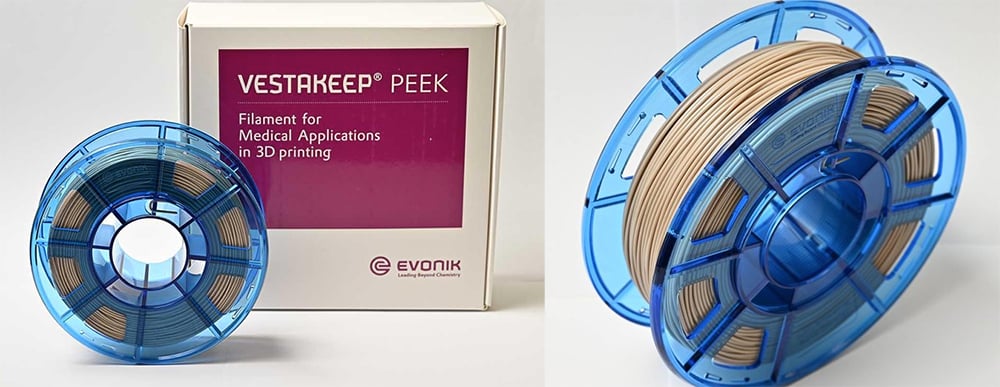
Many polymers, such as PLA, PEEK, and nylon are biocompatible by nature, but that does not mean that all PLA, PEEK, and nylon 3D printing filaments are biocompatible. There are often additives in the polymer filaments to make them perform better during 3D printing or colorants. So to make biocompatible products, you need to start with a certified biocompatible filament, which only comes from a few makers, including Solvay, Evonik, DSM, and Stratasys.
Another consideration in your polymer selection is how it stands up to sterilization and various chemical disinfectants. Some cleaning chemicals used on polymers can start to break down the material. Most manufacturers of biocompatible filaments will detail in the technical specifications whether parts 3D printed with their material, can stand up to specific chemical exposure and sterilization methods.
Resin
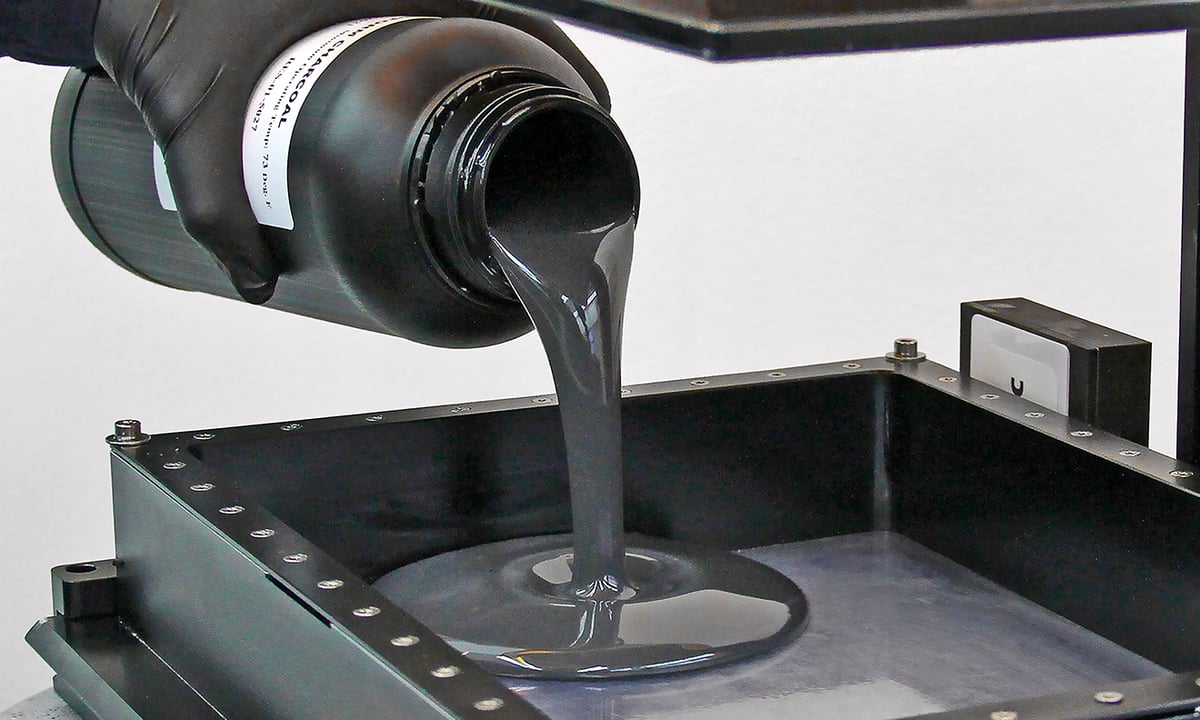
Resin is the generic term for a photopolymer, which is a type of liquid plastic that hardens when exposed to UV light. There are various 3D printing technologies that use resin, including the three types you’ll find in consumer and professional resin printers. Among the different types of resin printers, you’ll find stereolithography (SLA), digital light processing (DLP), and liquid crystal display (LCD) — along with, more industrial, material jetting technologies, including PolyJet.
Resins are an excellent choice for models with a high degree of detail and for professional use, engineering-grade resins are strong enough to be machined after curing and are used for everything from auto parts to dentures. High-temperature resins are a cost-effective means to produce injection molds for small-scale production runs.
Unlike plastic filament, resins don’t have a specific chemical composition name, and most resins are proprietary blends with general names, such as standard or tough. Resins are widely used in the dental industry and often identified with a name indicating the intended use, such as “surgical guide resin.” The article linked below has a full guide to dental resins.
Standard Resins
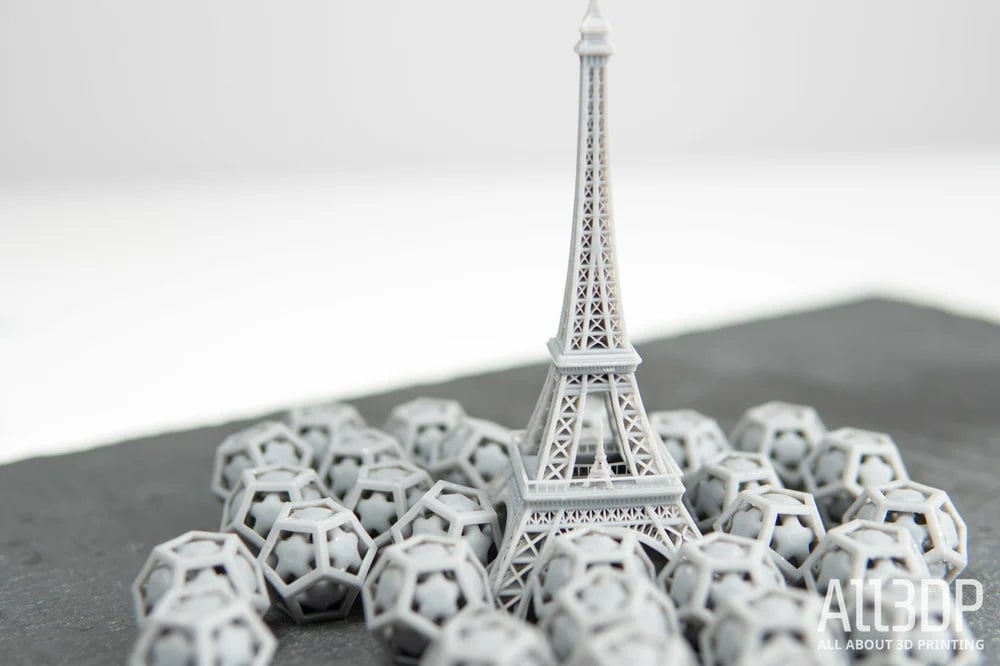
If you’re using an SLA, DLP, or MSLA printer, you’re going to need some resin. Resin can feature all kinds of different properties, but if you’re looking for something straightforward, standard resin’s the way to go.
It’s perfect for applications like creating conceptual models, functional models, prototypes, miniatures, and visual arts.
Standard resins come in a range of colors and, like all other resins, can be pretty stinky, so be sure to use them in well-ventilated areas.
Rapid Resins
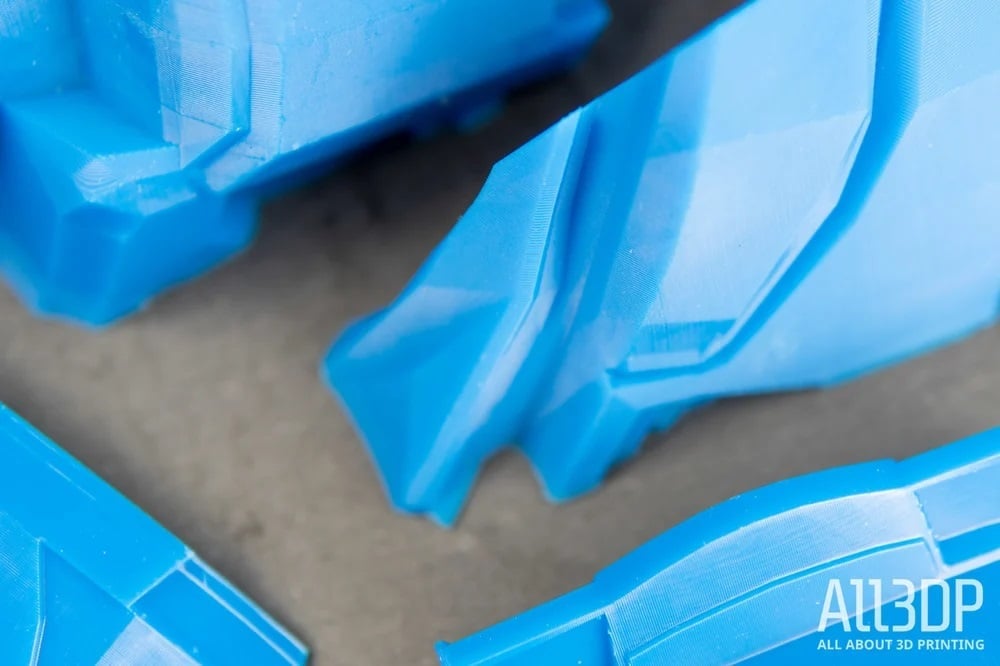
Resin that cures quickly has multiple benefits beyond a quick turnaround. The shortened time frame prevents shrinking and deformation of parts still soft from the bath. Use this resin if precision is needed, such as when making tools or components, and if waiting isn’t your strong suit.
Rapid resin is also sometimes referred to as “raft resin”, depending on the manufacturer
Tough Resins
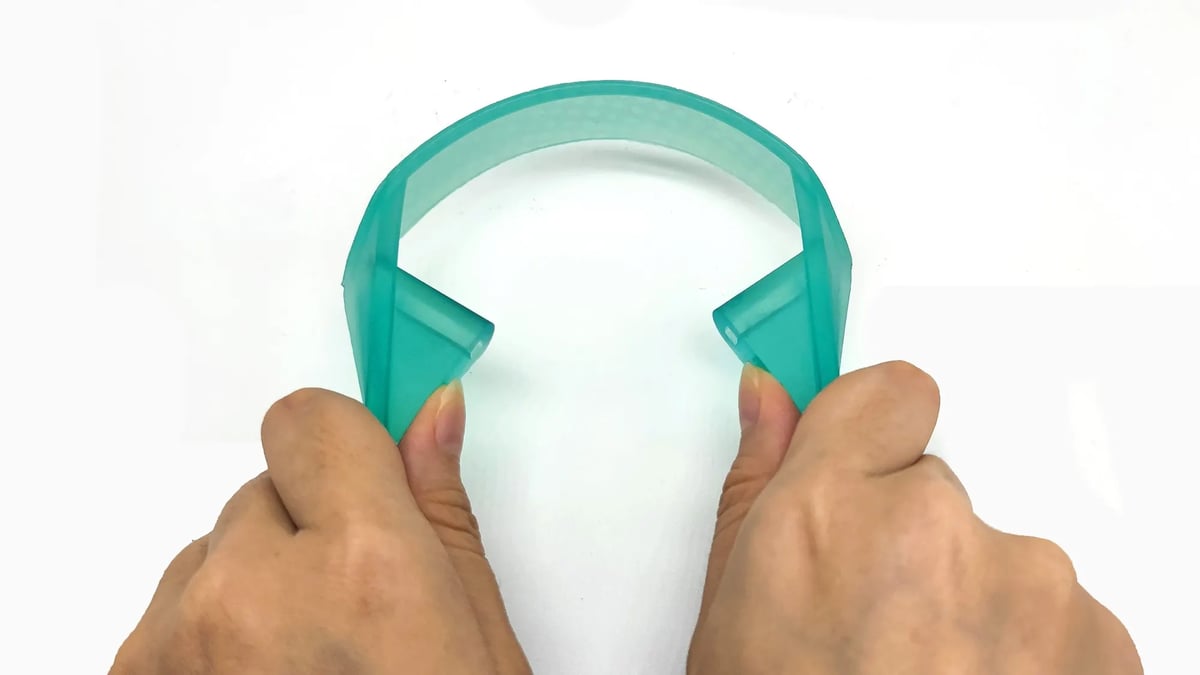
Marketed under many different names, ABS-like “tough resins” boast a high level of impact resistance.
Acrylonitrile butadiene styrene (ABS) is a plastic commonly used in toy manufacturing, personal protective equipment such as hard hats and helmets, and other uses where the object will be put through stress. ABS-like resins are not really made of ABS, but try to mimic its excellent physical and mechanical properties.
Tough resin is ideal for conceptual models, functional parts, and prototypes.
Water-Washable Resins

Water-washable resins take away a lot of the mess and stink factor of standard resins because, well, they’re water washable.
That means that instead of using alcohol to clean your parts, you use water. This is a safer, cleaner alternative to use if you’re new to resins, are looking for something that’s easier to work with, hate the smells from printing with resin, or would just like to save some money.
Flexible Resins
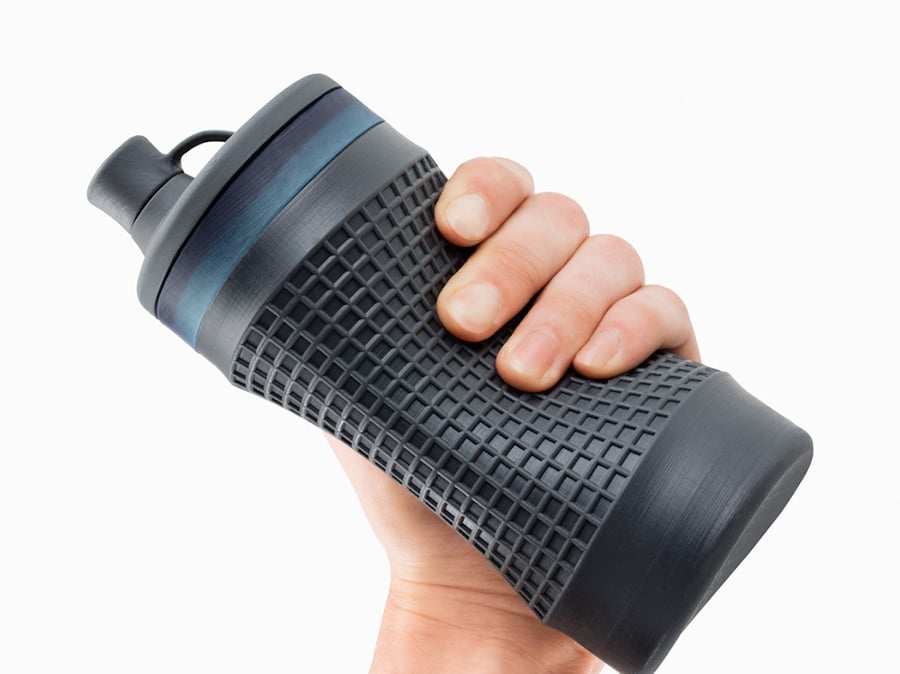
Sometimes, you need to be a little flexible. FDM printers use thermoplastic polyurethane (TPU), a rubber-like material found on drop-proof mobile phone cases.
But if you’re in the market for a TPU-like resin, it often goes under the line name “Flex” and can be similarly used for items where high elasticity and vibration absorption are needed, such as wheels.
Castable & Wax Resins

A major advantage of 3D printing is its ease and speed in prototyping, and castable resin combined with the lost wax method is a prime example of that. A wax model is encased in a plaster-like medium that hardens and is then heated, so the wax model melts away, leaving a mold that’s then filled with liquid precious metal.
This way, jewelers can print a model, use it to form a cement mold, and burn away the resin in a furnace, allowing the liquid metal to be poured into its place. A single 3D printed ring or brooch in this castable resin can form the mold for dozens in gold, silver, or other metals.
Castable resin 3D makes it possible to create a finely detailed master wax model.
Transparent/Clear Resins
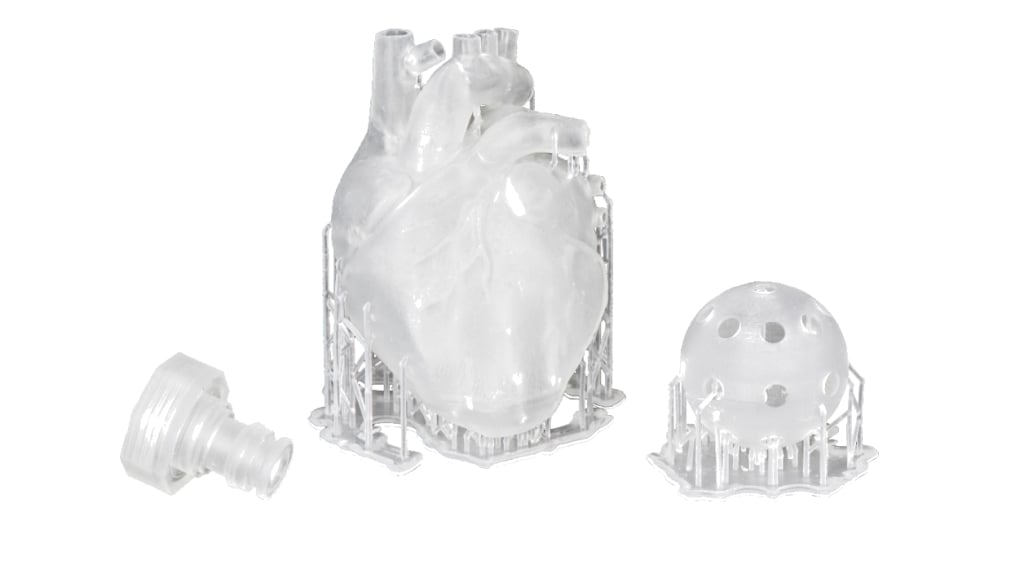
Transparency is somewhat of a holy grail when it comes to resin 3D printing. While more and more resins are entering the market that promise transparency, the truth is that often further processing steps like clear-coating, wet-and-dry sanding, and buffing are required to achieve truly glass-like results.
Therefore it depends on the geometry of the model and methods used, but some truly remarkable results can be achieved. Clear resin is popular in prototyping and model-making but really shines in medical applications including dental splints and medical models.
Glow-in-the-Dark Resin

Whether you’re making safety reflectors for your night-time runs or spooky figurines for your tabletop roleplaying game, glow-in-the-dark effects are cool.
FDM printers often have a hard time dealing with the additives to make the filament glow – wrecking tubing and hot ends – but resin printers have no problem with this material.
Biocompatable & Dental Resins

Medical and dental professionals require special resins that are approved for contact with patients, either for quick dental try-ons, for permanent implants or for products such as hearing aids or orthopedic braces. This is why the biocompatible resin market is huge and mostly filled with material makers that don’t make any other type of resin.
If you own a resin 3D printer that’s marketed specifically for dentists, like the Sprintray Pro S or the Rapid Shape D20+, it will come with a list of compatible dental-specific resins, but you can often use third-party resins. You don’t need a specific resin printer or use biocompatible materials, however.
Keep in mind that regulations on biocompatibility vary from the US to the EU to Asia and India. If you’re considering using 3D printing to manufacture and bring to market a medical device, such as an orthopedic brace or medical model, check out our guide to biocompatible materials linked below.
Plant-Based Resin

Using soybeans and similar plants as the setting agents for the resin, rather than traditional sources, plant-based resins make some small steps towards making resin 3D printing less toxic and messy.
Be sure to check out the material safety data sheet for any plant-based resin you buy – don’t always assume you can wash it or toss it out in the trash.
Metal Resin
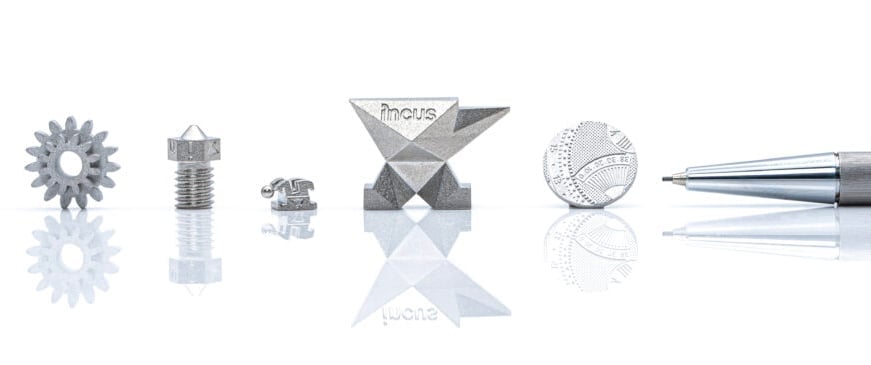
You can 3D print with metal-infused resin and, after some post-processing steps, end up with 100% metal parts, but this is only an industrial process and not available to consumers.
Called metal lithography or lithography-based metal manufacturing (LMM), this technology uses photosensitive resin containing metal power, called slurry, as feedstock. This light-sensitive slurry is selectively polymerized layer by layer with light. Metal lithography boasts excellent surface quality and is mostly, but not exclusively, used in micro 3D printing, so it has extremely high detail.
After printing, the “green” parts have their polymer component removed, leaving fully metal “brown” parts that are finished in a sintering process in a furnace. Feedstocks include stainless steel, titanium, tungsten, brass, copper, silver, and gold.
Metals
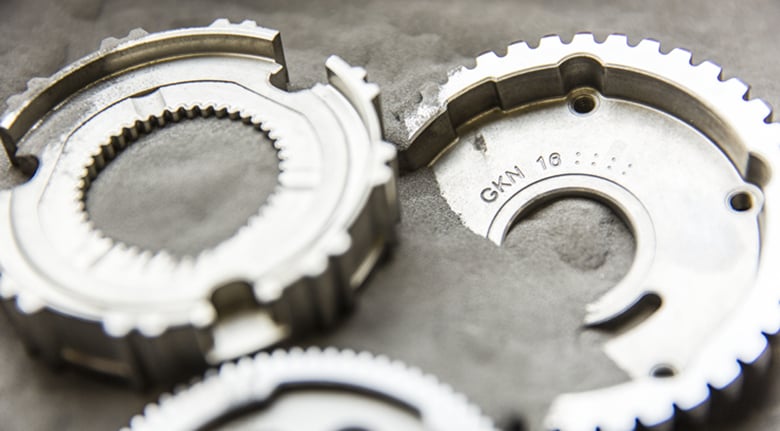
3D printing metal parts and products is widely used in professional and industrial settings but is also gaining ground with consumers.
We’ve already covered the metal filaments available in the section above, so here we’ll take a look at the more often used metal feedstock for 3D printers: metal powder. Other forms of metal used in metal 3D printing include metal wire, which is often the same metal wire used for welding, making it an economical option. Yet, typically, metal for 3D printing is made for 3D printing, although some metals used in injection molding will also work in 3D printers.
If you’re looking to understand how to 3D print with metal and its pros and cons and best printers, check out our Metal 3D Printing – The Ulitmate Guide.
Below we cover the main metals used in 3D printing, not every metal because virtually any metal can be used in 3D printing.
For example, Swedish jewelry manufacturer Arlid Links worked with a material maker to come up with a printing process to make jewelry out of metal powder recycled from illegal weapons.
Steel & Stainless Steel
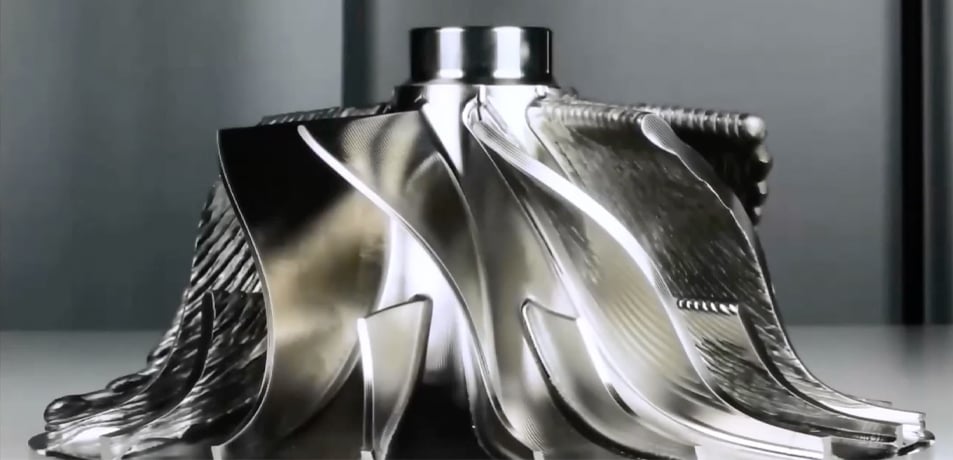
Steel is highly resistant to corrosion and heat, and it’s a lightweight and affordable metal, making it ideal for 3D printing. Today, manufacturers 3D print with steel because it’s faster and cheaper than CNC machining, casting, or forging. For companies that need one injection mold or a just a few replacement parts, 3D printing is the go-to choice.
You can use steel and stainless steel in almost every type of 3D printing, from economic filament for desktop FDMs to powder for binder jetting and laser powder bed fusion, and even resin. In fact, we have two full guides to 3D printing with steel and 3D printing with stainless steel.
Common Steels for 3D Printing:
- Stainless steels (316L, 304L , 17-4 PH, 15-5PH, 420, 254, PH1, GP1, 630, 410)
- Tool Steels (D2, M2, H13, H11, MS1, 1.2709)
- Low Alloy Steels (4140)
- Case Hardening Steel (20MnCr5)
Titanium
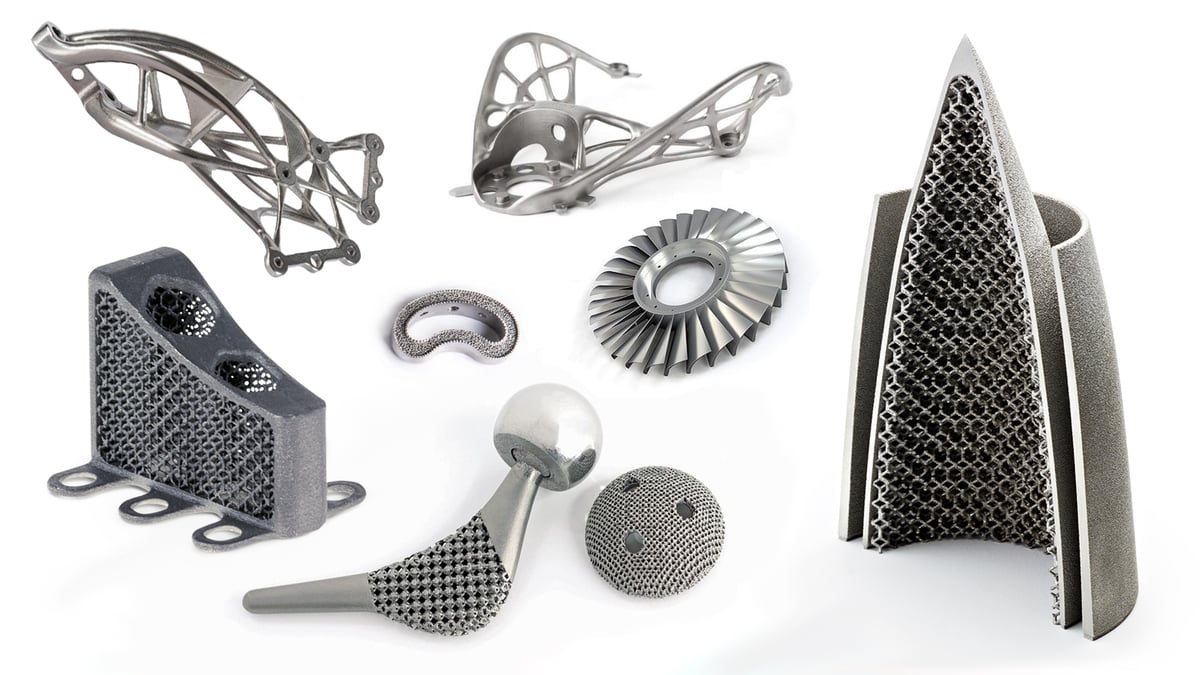
Titanium – strong as steel but half as heavy – is a complex metal to work with, but it is practically born to be 3D printed.
Titanium has become the most commonly used metal in additive manufacturing, widely employed in aerospace, joint replacements and surgical tools, race cars and bicycle frames, electronics, and other high-performance products.
Titanium and titanium-based alloys offer high mechanical strength, a high strength-to-weight ratio, and better corrosion resistance than stainless steels. It makes rockets and planes lighter, which saves fuel and increases payload capacity. In the aerospace industry, several titanium-based additively manufactured parts approved by the US FAA are currently in commercial and military use, with numerous other prototypes making their way toward certification. 3D printed titanium is prized for its low “buy-to-fly” ratio.
In the medical industry, 3D printed titanium implants have been successful across spine, hip, knee, and extremity applications due to the metal’s inherent biocompatibility and good mechanical properties combined with 3D printing’s ability to tailor porous structures enabling bone integration and mass customization for better patient outcomes.
There’s such a range of titanium materials to 3D print with that we created a complete titanium guide, linked below.
Aluminum
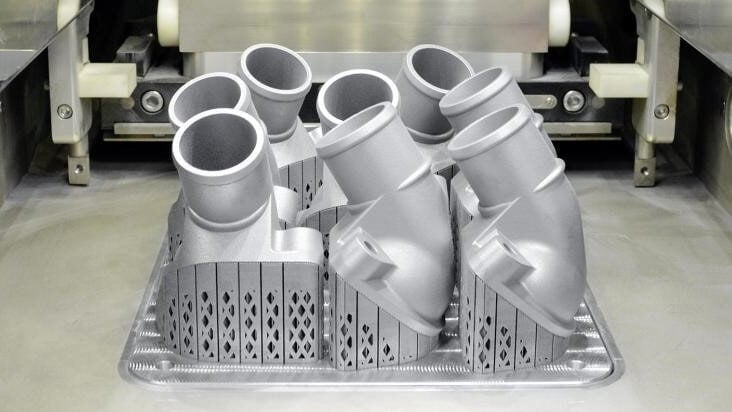
For aerospace, automotive, and industry, the lightweight and chemical-resistant attributes of aluminum parts are further enhanced by the design freedom and cost efficiency of 3D printing. Aluminum and alumium alloy use in 3D printing is surging because this metal is economical and easy to 3D print.
As with most metals, aluminum is available as a filament, powder or wire for various 3D printing technologies.
Aluminum alloys feature good chemical resistance, are very lightweight, and feature one of the best strength-to-weight ratios of any metal. Combined with silicon and magnesium, it’s the choice of many in the aerospace and automotive industry for its ability to withstand harsh conditions.
For FDM, only two companies currently offer an aluminum metal filament (The Virtual Foundry and Zetamix), which requires post-processing steps to achieve a more than 90% metal part. These are most commonly used for prototype metal parts rather than functional ones.
There’s such a range of aluminum materials to 3D print with that we created a complete aluminum guide, linked below.
Copper
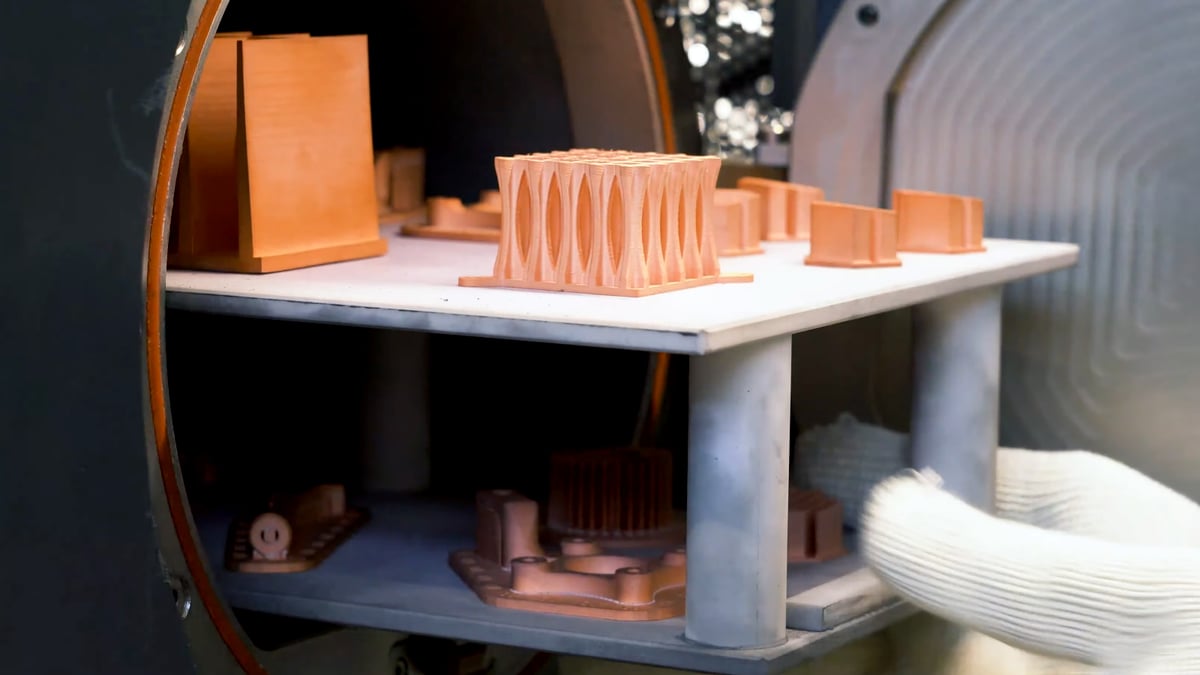
3D printing with pure copper and space-age copper alloys is possible with a range of metal 3D printers and services. You can create quick copper prototypes with copper filament on an FDM 3D printer and large copper rocket thrusters using copper alloys on laser powder bed fusion 3D printers. There’s also copper wire and copper resin, which is used for micro 3D printing.
In fact, copper plays a huge role in global sustainability objectives as a key part of electric motors, charging infrastructure, solar power, and batteries. One company from Chile called Copper3D produces a copper-filled filament that doesn’t produce metal parts but instead ones that feature the antibacterial and antimicrobial properties of copper.
There’s such a range of copper materials to 3D print with we created a complete copper guide, linked below.
Precious Metals
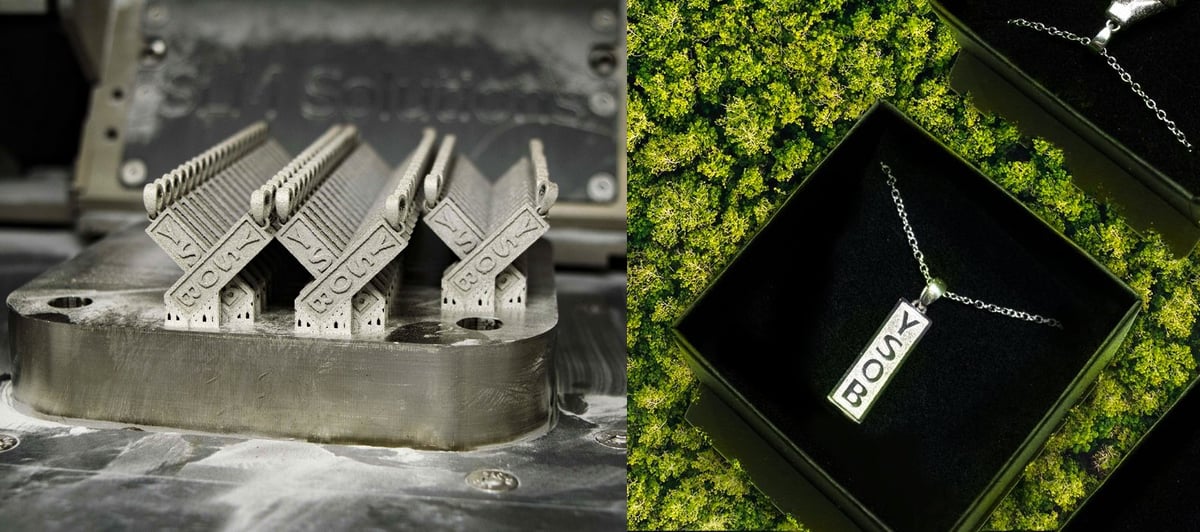
Gold, silver, and platinum are 3D printable metals available in powder form and used with laser powder bed fusion 3D printers, albeit not widely. Even though there’s very little material waste in metal 3D printing, filling a powder bed with gold is pricy and hasn’t caught on with the wider jewelry market.
Silver 3D printing is a bit more common and enables jewelry manufacturers to offer customized items without the need to make a mold first.
When you hear mention of 3D printing for jewelry, it usually refers to 3D printing the wax model used to make the mold for an item, not 3D printing the item itself.
Bronze
Need a custom bronze statue, or fancy minting your own bronze coins? If you can 3D print it, chances are you can get it in bronze. Just like 3D printing in gold and silver, there are various methods of 3D printing that apply to bronze, but typically it involves bronze powder used in a laser powder bed fusion, cold spray, or binder jet 3D printer.
Bronze, and bronze alloys, are valuable materials for a wide range of industrial applications. Bronze is often important for its spark-resistant qualities.
Of course, if you only need something that merely looks like bronze, check out the filaments in the Metalic Appearance section above.
Food
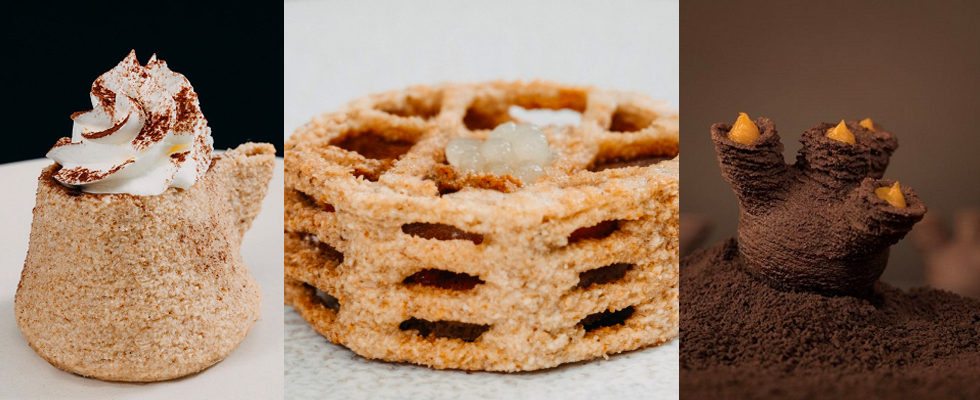
The foods that can be 3D printed are, essentially, anything that can be extruded since the process is similar to using a pastry bag. Food 3D printers extrude materials, such as purées, mousses, and other viscous foods like chocolate frosting. Just think of all the possible combinations between doughs, mashes, cheeses, frostings, and even raw meats.
Food 3D printers can pump out custom three-dimensional designs faster and more accurately than human hands, plus they have the ability to deliver extravagantly designed and customized edibles, which can distinguish one restaurant from another.
Printing speed, temperature, and nozzle size determine the type of material you can print with, and some food 3D printers even require you to purchase proprietary materials.
3D printed meat and meat substitutes are a growing market, but those printers are not commercially available. 3D printed lab-grown meat is similar to bioprinting, so check out the biomaterial section below.
Silicone
Most of today’s silicone seals, joints, wearable technology, robotic gripers, and the like are made with injection or compression molding. It’s a process that requires a model, then a mold made from that model, then silicone injected into the mold.
3D printed silicone removes the model and mold steps entirely and simply prints the final part. This clearly saves an enormous amount of cost and time: up to 90% faster than injection molding, according to 3D printer maker 3D Systems.
But 3D printing silicone comes with challenges. Unlike solid polymer filaments that are malleable when heated and solidify once again when cooled, such as PLA or TPU. Silicone, once solidified, can’t be made pliable again. It’s also unlike photopolymer resins because silicones are highly resistant to UV light and cannot be cured in their pure form. Silicones require an additive to render the material sensitive to light or heat, the two conditions used in 3D printing to act as a trigger to initiate the polymerization reaction within the material (in other words, to solidify it).
This material complexity means that silicone requires special 3D printers. However, silicone-based materials (not 100% silicone) are more widely available today and work on many existing resin 3D printers. When silicones are used on resin 3D printers, such as from Carbon or B9 Creations, the silicone material is blended with other polymer resins and thus loses a few of its distinguishing characteristics while still being ideal for a wide range of applications.
There’s so much more to say about silicone and silicone-like materials that we created a complete silicone guide, linked below.
Technical Ceramics
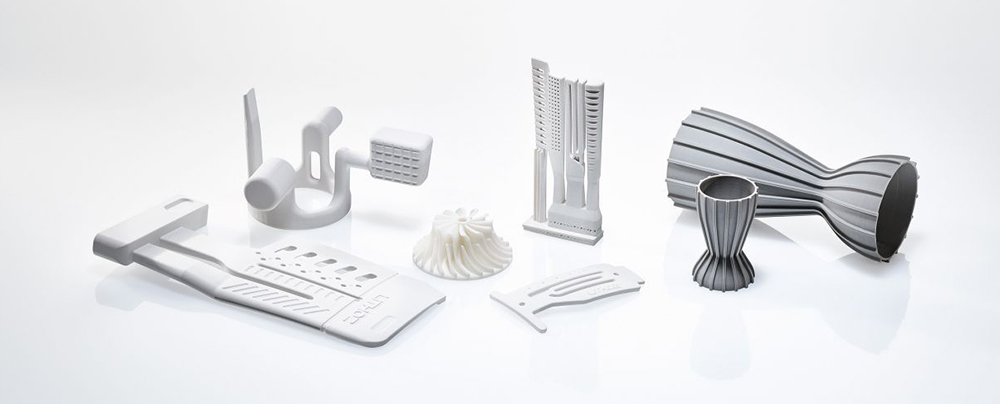
Even though there are countless metals and plastics to 3D print with, ceramic materials have unique properties that are extremely valuable in the high-tech manufacturing of everything from semiconductors and bone implants to rocket engines and cutting tools.
Unlike the ceramic material used in pottery, technical ceramics (also called industrial or engineering ceramics) have nothing to do with clay. They are available in various properties: strong as the hardest metal, heat resistant enough for deep space, porous to enable cellular growth in human implants, wear-resistant for demanding oil & gas industry applications, completely transparent but harder and stronger than glass, and electrically insulating.
- Extremely high heat resistant
- Ware and abrasion resistant
- Low thermal expansion
- Chemically inert (no corrosion)
- Electrically insulating
- High dimensional stability
- Bioinert and, in some cases, bio-reabsorbable
The technical ceramic materials themselves come in powders, viscus slurries and resins, and filaments. They are definitely some of the more expensive materials to 3D print with but their characteristics are unmatchable. Despite the current costs, more affordable technical ceramics may be on the horizon as new ceramic resins and filaments expand accessibility to this unique material family.
Common Technical Ceramics for 3D Printing:
- Alumina
- Zirconia-toughened Alumina
- Zirconia
- Tricalcium Phosphate
- Lead Zirconate Titanate
- Tungsten Carbide Cobalt
- Hydroxyapatite
- Silicon Nitride
There’s so much more to say about technical ceramics that we created a complete ceramic guide, linked below.
Pottery & Clay
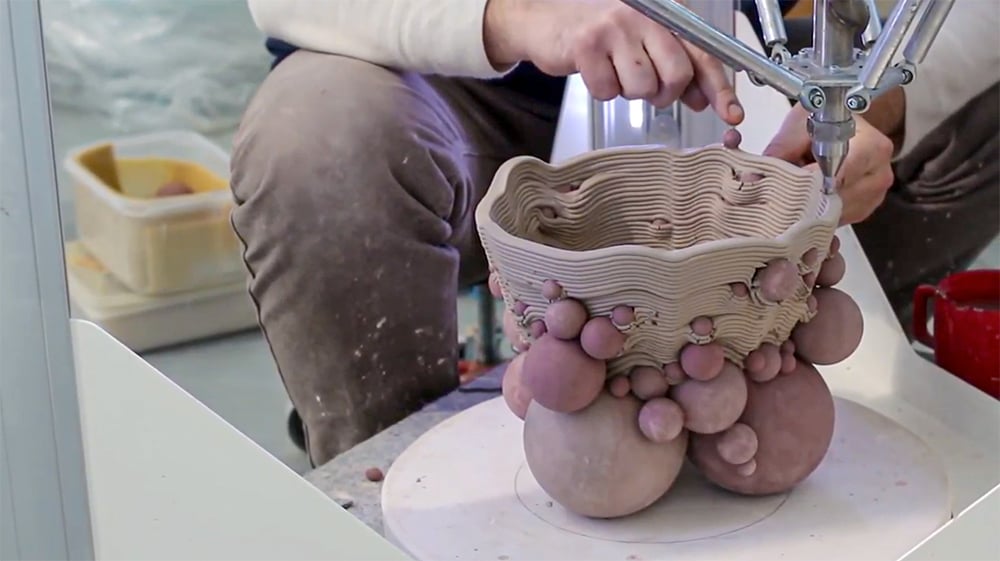
Most clay materials used in pottery today can be used in many pottery 3D printers. These machines extrude the clay just like an FDM printer extrudes plastic and no special or proprietary materials are required. There are desktop pottery 3D printers and large robotic arm pottery 3D printers and each have guidelines for the type of materials or rather the consistency of materials that they can extrude.
Concrete & Construction Materials
3D concrete printing technology is in use today for homes, architectural features, and construction projects from wells to walls. Proponents say it has the potential to significantly disrupt the entire construction industry if it can get over a few hurdles first.
Most often, 3D printable concrete is actually a cement-based mixture of several materials, including super-plasticizers that remove water from the mix for faster drying and fibrous materials for improved strength. The materials are more like a mortar. Providing similar functionality to concrete but with higher printability and sometimes better physical properties, the blends can be formulated for a specific purpose, such as printing walls for housing or for creating decorative architectural elements.
Most manufacturers create their own proprietary material blends, and as such, they’ve been optimized for their 3D printers (or for those of their immediate partners). Some examples of proprietary material blends include Icon’s Lavacrete and CyBe’s CyBe Mortar.
At present, these mortars are typically more expensive than standard construction cement but that could change soon. Mexican cement company Cemex and the German University of Technology in Oman, along with printer maker COBOD, recently 3D printed a test building using standard concrete.
There’s such a range of construction materials to 3D print with that we created a complete construction guide, linked below.
Biomaterials
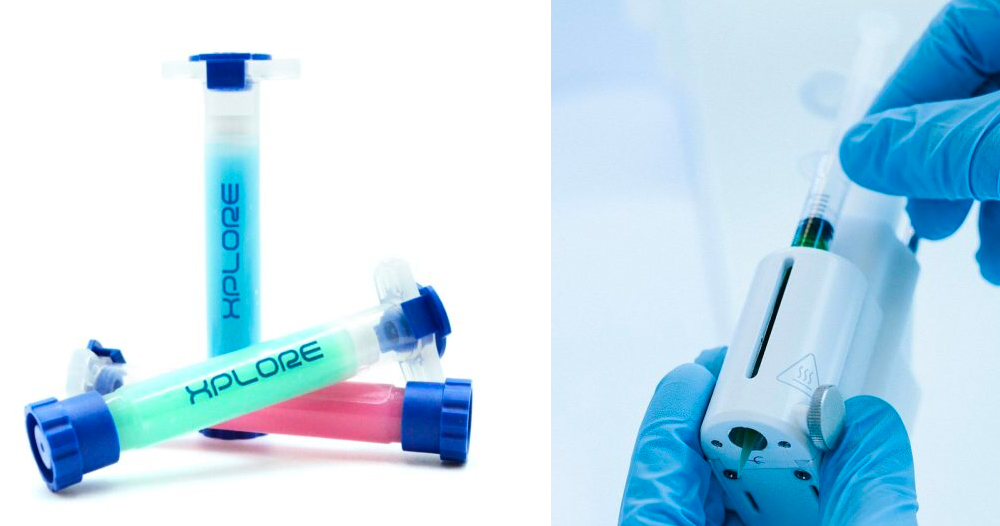
Although we are still very far from 3D printing functional organs, there are practical applications for 3D printing with living cells and other biomaterials. Bioprinting is a type of 3D printing that can potentially produce anything from bone tissue and blood vessels to living tissues for various medical applications, including tissue engineering and drug testing and development.
Today’s bioprinters use a material called bioink to produce engineered (artificial) live tissue using 3D printing technology. It can be composed only of cells, but in most cases, an additional carrier material that envelops the cells is also added. This carrier material is usually a biopolymer gel, which acts as a 3D molecular scaffold. Cells attach to this gel, and this enables them to spread, grow and proliferate.
Importantly, the gel can also provide protection to the cells during the printing process. Its importance is so high that the term “bioink” is often commonly used to describe the carrier material alone, irrespective of the cells that may grow on it.
License: The text of "All 3D Printing Materials – The Ultimate Guide" by All3DP Pro is licensed under a Creative Commons Attribution 4.0 International License.
CERTAIN CONTENT THAT APPEARS ON THIS SITE COMES FROM AMAZON. THIS CONTENT IS PROVIDED ‘AS IS’ AND IS SUBJECT TO CHANGE OR REMOVAL AT ANY TIME.





























